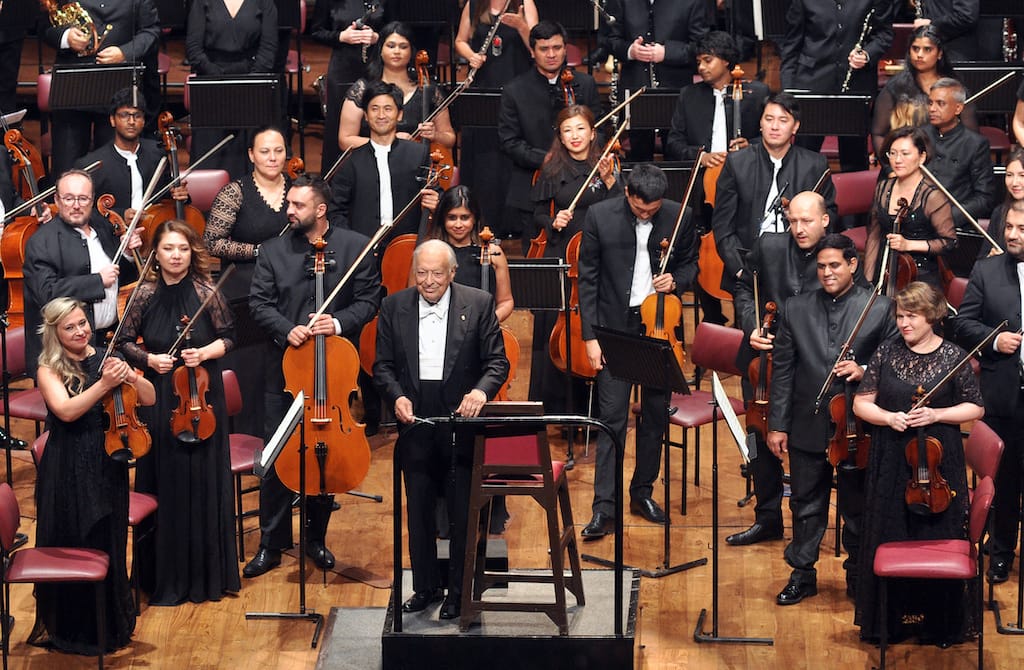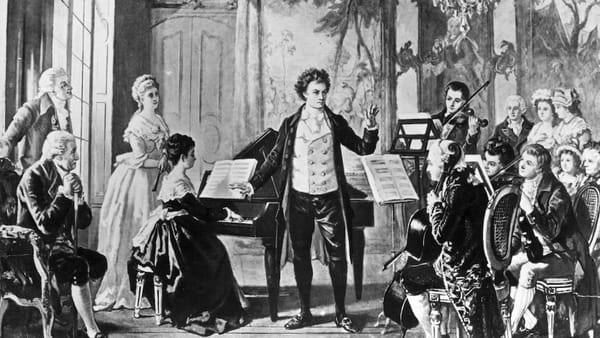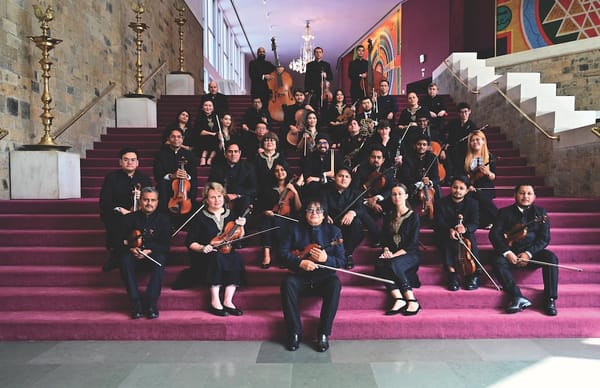A True Meeting of Musical Minds

Starting in 1886 with the symphonic fantasy Aus Italien, Richard Strauss composed a series of programmatic orchestral works—Don Juan (1888-89), Tod und Verklärung (also 1888-89), Macbeth (1888-1891), Till Eulenspiegel (1894-95), Also sprach Zarathustra (1896), Don Quixote (1897), Ein Heldenleben (1897- 98), Symphonia Domestica (1902-03) andEine Alpensinfonie (1911-15)—of which all but two are in the repertoire of every great professional symphony orchestra. These works, of which the majority were termed “tone poems” by Strauss, extended the range and scope of Franz Liszt’s symphonic poems, and are, along with his operas, Strauss’s most lasting contributions to the active repertoire. Don Juan sealed the 24-year-old Strauss’s international reputation and, along with Till Eulenspiegel and Also sprach Zarathustra, remains among the most popular of his works. Ein Heldenleben, Symphonia Domestica and Eine Alpensinfonie have had a more mixed critical reception but have never dropped out of the repertoire. The first and the last of this series of orchestral pieces are inspired by places—Italy and the Bavarian Alps. Don Juan, Till Eulenspiegel, Also sprach Zarathustra and Don Quixote take their cue from literary works or figures from folklore, while Ein Heldenleben and Symphonia Domestica are frankly autobiographical. Evocative and dramatic in turns, the tone poems cover a wide range of emotions. Zubin Mehta, with his famed ear for orchestral sounds and his mastery over the operatic repertoire, has always been a top-notch interpreter of Strauss’s tone poems, and it is a rare privilege for audiences in Mumbai to hear him conduct two of these with India’s only professional symphony orchestra.
Despite their diverse sources of inspiration, Strauss’s tone poems are connected to each other not only through his trademark stylistic features but also by his penchant for quotations of, and allusions to, both his own music and those by others. Such direct references are minimal in Don Juan, the earliest of the pieces to be featured in the two concerts of Strauss’s music at the NCPA, although the opening of the piece owes something in terms of its musical language to the Act III Prelude from Richard Wagner’s Lohengrin, the first love episode (introduced by solo violin) to Wagner’s Tristan und Isolde and the recapitulation of the opening material after a disconcerting, suspenseful pause to a similar moment in Liszt’s symphonic poem Tasso. What is interesting in any piece, however, are the new elements that a composer brings to a pre-existing musical language, thereby sowing the seeds of change. In this regard, what is remarkable about this early tone poem is the intensity with which Strauss portrays Don Juan’s disquiet, his fluctuating moods, his mental state. These sections, which are contrasted with love music of passionate intensity (as in the first love episode) and unforgettable tenderness (as in the second love episode introduced by the oboe), give the tone poem a frisson that has thrilled audiences for more than a century. Indeed, Strauss would go on to portray such figures with great sympathy in works like Don Quixote and the operas Salome and Elektra.
In contrast to Don Juan, few works by Strauss are as replete with self-quotations as Ein Heldenleben [A Hero’s Life]. There was an ostensible reason. Strauss once declared, with tongue in cheek, that he composed his piece from “a desperate need” since “Beethoven’s Eroica is so extremely unpopular with our conductors and hence rarely performed.” In all likelihood Strauss was not being serious, but it is also undeniable that he was a megalomaniac and wanted to leave no doubt about who the hero was. Hence, in the section from Ein Heldenleben titled ‘The Hero’s Works of Peace’, there are no less than 30 quotations from Strauss’s own tone poems, songs and the only opera he had composed till then (Guntram), starting with the magnificent horn theme and the solo violin melody from Don Juan—slightly but thrillingly reharmonised. Another point of continuity is offered by the use of the solo violin to represent a woman, this time the composer’s wife and soprano Pauline de Ahna, who was known to be extremely temperamental (her incorrect assumption of an extramarital affair on Strauss’s part led the composer to write his comic opera Intermezzo in 1924). The writer and musicologist Romain Rolland wrote:
I asked Strauss about the hero’s wife, who had intrigued the audience so greatly—some found her a perverse woman, others a coquette, etc. He said: ‘Neither one nor the other. A little of all that. It’s my wife I wanted to show. She is very complex, very feminine, a little perverse, a little coquettish, never like herself, at every minute different from how she had been the moment before.
While the long and difficult violin solo in the earlier part of the piece fully captures these various moods, the radiant closing section of the tone poem, in which the solo violin enters into a duet with a solo horn (representing the hero/Strauss himself), eloquently expresses the love between them, Pauline’s difficult nature notwithstanding. Indeed, there is a whiff here of the tranquil slow movement of Beethoven’s Violin Concerto, a piece that Strauss greatly loved, and the tone poem’s hero finally finds fulfilment not in the thrills of victory in war but in the love and companionship offered by his wife. As such, Ein Heldenleben, like Strauss’s other tone poems explicitly concerned with the heroic element—Also sprach Zarathustra and Don Quixote—avoid ending on a note of triumphant exaltation that characterises the most famous of Beethoven’s heroic orchestral works—the Emperor Concerto, and the Eroica and the Fifth Symphonies.
By the early 1900s, Strauss had moved into opera, producing some memorable roles for female voices, of which he had acquired a deep understanding through Pauline, whose exquisite singing skills had led one of Strauss’s most irascible critics, Eduard Hanslick, to describe her as “his better and more beautiful other half.”4 This profound understanding of the female voice and command over the orchestra came to good use in Strauss’s penultimate piece, the so-called Vier letzte Lieder [Four Last Songs], composed in 1948 but first performed posthumously in 1950. (The last of his compositions, the song ‘Malven’, was discovered in 1982). Composed in an idiom that was ostensibly outdated, these orchestral songs have remained far more firmly in the repertoire than any of the cutting-edge work then produced by the self-styled avant-gardists of the day. The first performance was given by the great soprano Kirsten Flagstad with the Philharmonia Orchestra conducted by Wilhelm Furtwängler, one of Mehta’s favourite conductors. The London premiere at the Albert Hall on 22nd May 1950 had an Indian connection: it was sponsored by Jayachamarajendra Wadiyar, the Maharaja of Mysore, who also supported other Indian and foreign musicians, and helped Herbert von Karajan re-establish his post-war career by sponsoring recordings of some unusual French and Russian repertoire that the Maharaja was interested in. At the premiere, the songs were not sung in the order in which they are now normally performed. In the order that is now established, the last song, ‘Im Abendrot’ (‘In the Twilight’) ends with a quotation from the tone poem Tod und Verklärung (Death and Transfiguration), which sounds more touching in this new context. Maestro Mehta has conducted the Vier letzte Lieder before with acclaimed Bulgarian soprano Krassimira Stoyanova and the orchestra of the La Scala opera house, Milan, and one looks forward to hearing them perform the piece once again, this time with the SOI.
Although Mehta has recorded many of the tone poems several times, he has been more of a champion of the once less-popular tone poems such as Don Quixote, Symphonia Domestica and Eine Alpensinfonie. To the best of my knowledge, Mehta recorded Don Juan commercially only once, with the Los Angeles Philharmonic (a splendid version), while the Vier letzte Lieder seems to be a late addition to his repertoire. These Mumbai performances should be, therefore, of the greatest interest, since they feature Strauss’s works that Mehta has not performed or recorded as often as some others. To those who are curious to explore further, I warmly recommend the eight-CD set devoted exclusively to Mehta’s recordings of Strauss on Sony. This set includes a complete recording of Salome with the Berlin Philharmonic and of orchestral excerpts from Strauss’s operas, including a lively rendition of the First Waltz Sequence from Der Rosenkavalier, in which the spirit of Richard Strauss meets that of the other great Strauss—Johann—of whose music Mehta is equally a master interpreter.
END NOTES
- From 1885 onwards, Strauss’s mother, whom he deeply loved, used to have periods of mental suffering. See Michael Kennedy, Richard Strauss: Man, Musician, Enigma (Cambridge University Press, 1999), 10.
- In order to understand what the Eroica really meant to him, one has to hear Strauss’s last orchestral work, the deeply tragic Metamorphosen (1945), which quotes from the Funeral March of Beethoven’s greatest symphony.
- Quoted in Normal del Mar, Richard Strauss: A Critical Commentary on his Life and Works, vol. 1 (Faber, [1962] 2009), 171.
- Kennedy, op. cit., 89.
By Suddhaseel Sen. This piece was originally published by the National Centre for the Performing Arts, Mumbai, in the August 2024 issue of ON Stage – their monthly arts magazine.





